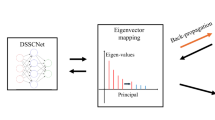Abstract
Sparse coding methods have shown the superiority in data representation. However, traditional sparse coding methods cannot explore the manifold structure embedded in data. To alleviate this problem, a novel method, called Structure Preserving Sparse Coding (SPSC), is proposed for data representation. SPSC imposes both local affinity and distant repulsion constraints on the model of sparse coding. Therefore, the proposed SPSC method can effectively exploit the structure information of high dimensional data. Beside, an efficient optimization scheme for our proposed SPSC method is developed, and the convergence analysis on three datasets are presented. Extensive experiments on several benchmark datasets have shown the superior performance of our proposed method compared with other state-of-the-art methods.




Similar content being viewed by others
References
Zhao W, Chellappa R, Phillips PJ et al (2003) Face recognition: a literature survey. ACM Comput Surv (CSUR) 35(4):399–458
Turk M, Pentland A (1991) Eigenfaces for recognition. J Cognit Neurosci 3(1):71–86
Belhumeur PN, Hespanha JP, Kriegman DJ (1997) Eigenfaces vs. fisherfaces: recognition using class specific linear projection. IEEE Trans Pattern Anal Mach Intell 19(7):711–720
Lee JM, Yoo CK, Choi SW et al (2004) Nonlinear process monitoring using kernel principal component analysis. Chem Eng Sci 59(1):223–234
Liu T, Tao D, Xu D (2016) Dimensionality-dependent generalization bounds for k-dimensional coding schemes. Neural Comput 28(10):2213–2249
Shu Z, Fan H, Huang P et al (2017) Multiple Laplacian graph regularized low rank representation with application to image representation. IET Image Process 11(6):370–378
Belkin M, Niyogi P (2003) Laplacian eigenmaps for dimensionality reduction and data representation. Neural Comput. 15(6):1373–1396
Roweis ST, Saul LK (2000) Nonlinear dimensionality reduction by locally linear embedding. Science 290(5500):2323–2326
Tenenbaum JB, de Silva V, Langford JC (2000) A global geometric framework for nonlinear dimensionality reduction. Science 290(5500):2319–2323
Lee D, Seung H (1999) Learning the parts of objects by non-negative matrix factorization. Nature 401:788–791
Cai D, He X, Han J (2011) Locally consistent concept factorization for document clustering. IEEE Trans Knowl Data Eng 23(6):902–913
Liu T, Gong M, Tao D (2017) Large-cone nonnegative matrix factorization. IEEE Trans Neural Netw Learn Syst 28(9):2129–2142
Shu Z, Zhao C, Huang P (2015) Local regularization concept factorization and its semi-supervised extension for image representation. Neurocomputing 152(22):1–12
Li Z, Liu J, Lu H (2013) Structure preserving non-negative matrix factorization for dimensionality reduction. Comput Vis Image Underst 117(9):1175–1189
Liu T, Tao D (2016) On the performance of manhattan nonnegative matrix factorization. IEEE Trans Neural Netw Learn Syst 27(9):1851–1863
Candès EJ, Romberg J, Tao T (2006) Stable signal recovery from incomplete and inaccurate measurements. Commun Pure Appl Math 59(8):1207–1223
Donoho DL (2006) Compressed sensing. IEEE Inf Theory Soc 52(4):1289–1306
Qian Y, Jia S, Zhou J et al (2011) Hyperspectral unmixing via L-1/2 sparsity-constrained nonnegative matrix factorization. IEEE Trans Geosci Remote Sens 49(11):4282–4297
Zou H, Hastie T, Tibshirani R (2006) Sparse principal component analysis. J Comput Gr Stat 15(2):265–286
Deng J, Zhang Z, Marchi E et al. (2013) Sparse autoencoder-based feature transfer learning for speech emotion recognition, In: IEEE affective computing and intelligent interaction, pp 511–516
Wright J, Yang A, Sastry S et al (2009) Robust face recognition via sparse representation. IEEE Trans Pattern Anal Mach Intell 31(2):210–227
Zheng M, Bu J, Chen C et al (2011) Graph regularized sparse coding for image representation. IEEE Trans Image Process 20(5):1327–1336
Liu W, Zha Z, Wang Y et al (2016) p-Laplacian regularized sparse coding for human activity recognition. IEEE Trans Ind Electron 63(8):5120–5129
Hong C, Yu J, Tao D et al (2015) Image-based 3d human pose recovery by multi-view locality sensitive sparse retrieval. IEEE Trans Ind Electron 62(6):3742–3751
Yu J, Rui Y, Tao D (2014) Click prediction for web image reranking using multimodal sparse coding. IEEE Trans Image Process 23(5):2019–2032
Geng B, Tao D, Xu C et al (2012) Ensemble manifold regularization. IEEE Trans Pattern Anal Mach Intell 34(6):1227–1233
Jin T, Yu Z, Li L et al (2015) Multiple graph regularized sparse coding and multiple hypergraph regularized sparse coding for image representation. Neurocomputing 154:245–256
Yu J, Hong R, Wang M et al (2014) Image clustering based on sparse patch alignment framework. Pattern Recognit 47(11):3512–3519
Shu Z, Zhou J, Huang P et al (2016) Local and global regularized sparse coding for data representation. Neurocomputing 198(29):188–197
Carreira-Perpinan MA (2010) The elastic embedding algorithm for dimensionality reduction. ICML 10:167–174
Donoho DL (2006) For most large underdetermined systems of equations, the minimal 1-norm near-solution approximates the sparsest near-solution. Commun Pure Appl Math 59(6):797–829
Kim SJ, Koh K, Lustig M, Boyd S, Gorinevsky D (2007) A method for large-scale l1-regularized least squares. IEEE J Sel Top Signal Process 1:606–617
Cands E, Romberg J (2006) \(l_{1}\)-magic: a collection of matlab routines for solving the convex optimization programs central to compressive sampling. www.acm.caltech.edu/l1magic/
Saunders M (2002) PDCO: Primal-dual interior method for convex objectives. http://www.stanford.edu/group/SOL/ software/pdco.html
Lee H, Battle A, Raina R et al (2007) Efficient sparse coding algorithms. Proc Adv Neural Inf Process Syst 20:801–808
Acknowledgements
This work was supported by the Grants of the National Natural Science Foundation of China [Grant Nos. 61472166, 61603159, 61672265, 61373055, 61503195], Natural Science Foundation of Jiangsu Province [Grant No. BK20160293], Jiangsu Key Laboratory of Image and Video Understanding for Social Safety (Nanjing University of Science and Technology) [Grant No. 30916014107], China Postdoctoral Science Foundation [Grant No. 2017M611695], and Jiangsu Province Postdoctoral Science Foundation [Grant No. 1701094B].
Author information
Authors and Affiliations
Corresponding author
Rights and permissions
About this article
Cite this article
Shu, Z., Wu, Xj. & Hu, C. Structure Preserving Sparse Coding for Data Representation. Neural Process Lett 48, 1705–1719 (2018). https://doi.org/10.1007/s11063-018-9796-6
Published:
Issue Date:
DOI: https://doi.org/10.1007/s11063-018-9796-6




